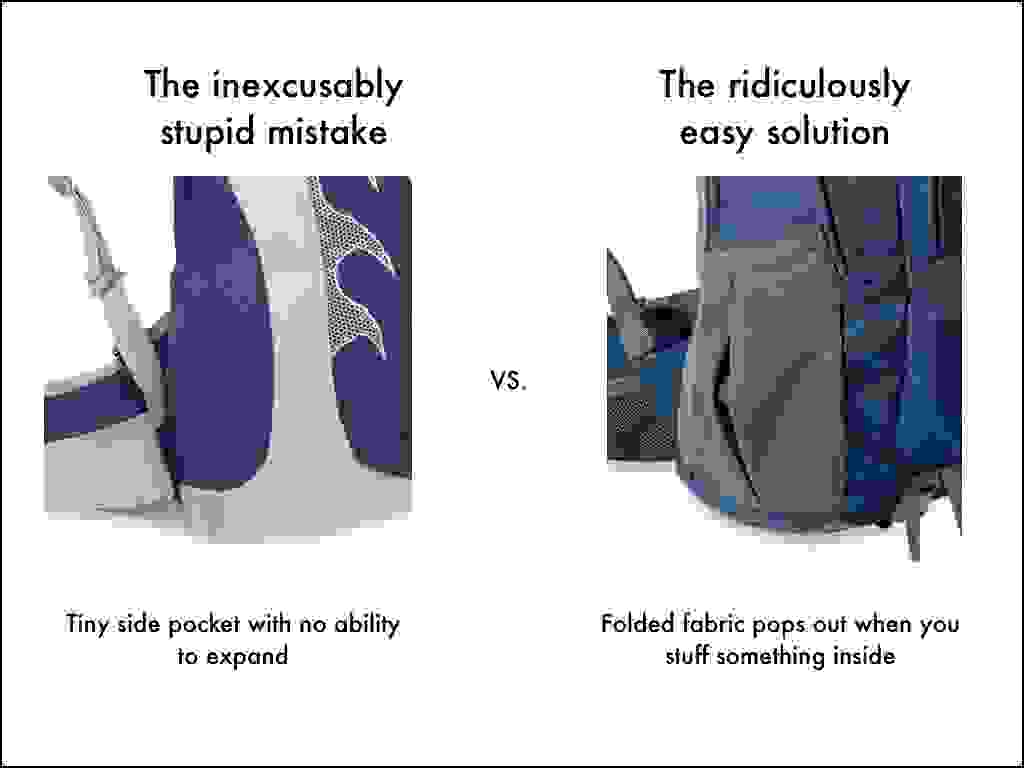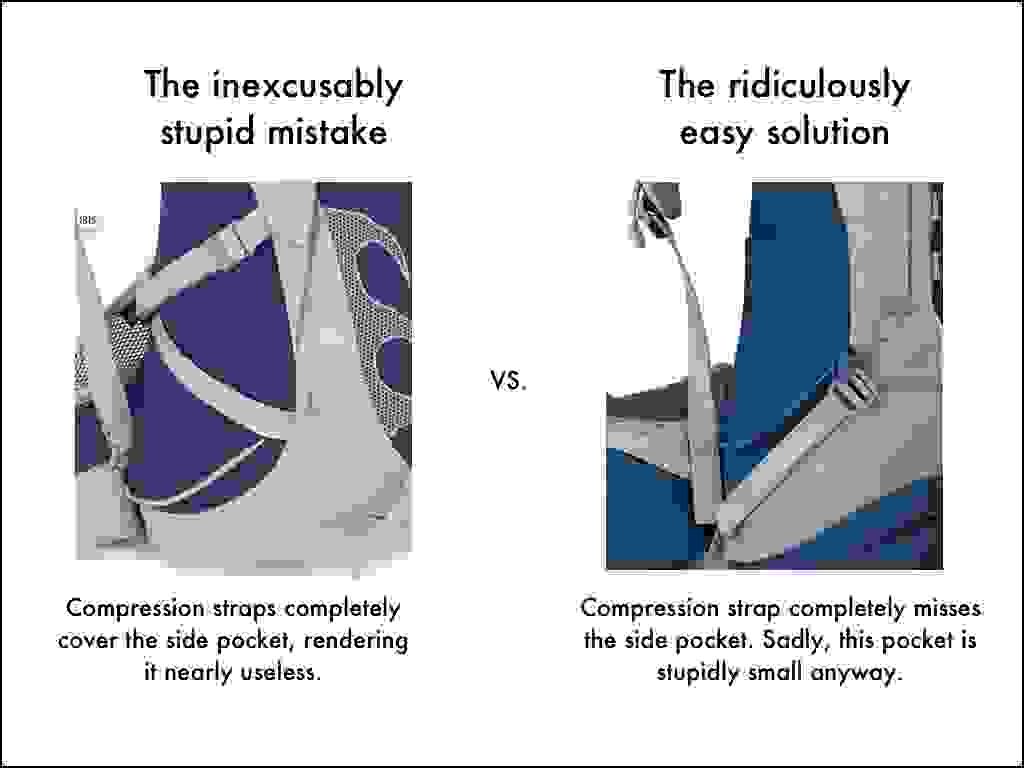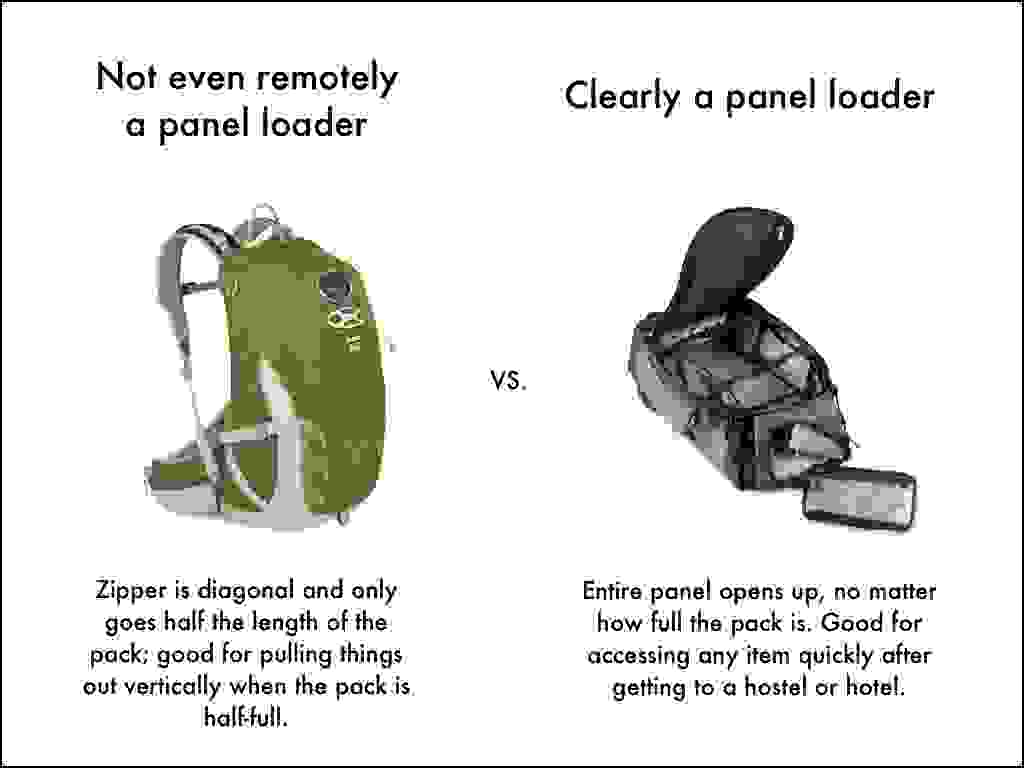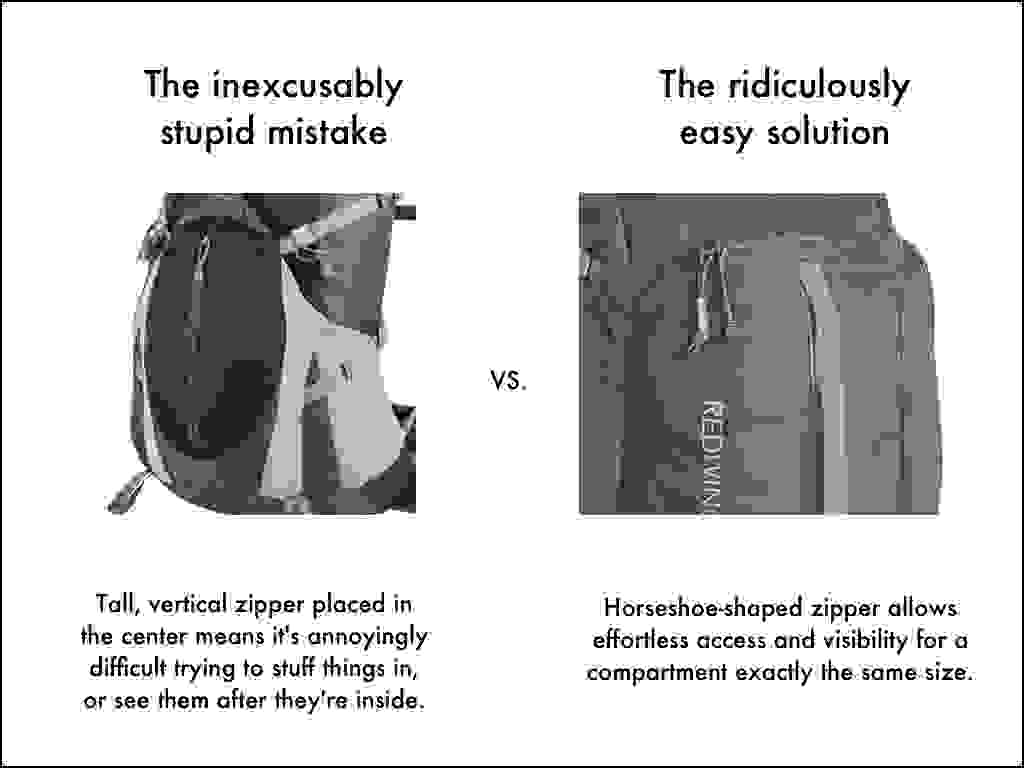As many of you may know, I am an endless complaining machine that cannot be satisfied even by the most magnificent of creations anywhere to be found. This debilitating curse manifests itself most thoroughly when it comes to high-tech travel gear, much of which is cartoonishly ruined by moronic designers who seem to have absolutely no idea that even the smallest of modifications could vastly improve their creations by several orders of magnitude.
I have no earthly idea how they’re able to screw things up so frequently, and many a strongly-worded-letter has departed from my desk, only to be cursorily answered or summarily ignored by the willfully foolish recipients whose job descriptions apparently do not include “making things not suck.”
So I’ll just complain here instead.

Backpack manufacturers make a massive variety of packs, churning out the designs every single year, with a billion different sizes, colors, configurations, and everything else. You’d think they’d provide enough variety to satiate the needs of even the most discerning of pack enthusiasts. But nay. Somehow they still manage to screw things up all over the place.
Now I’ll readily admit that in many cases, my subjective needs are not universally ideal; travel-specific packs require a somewhat different set of features compared to hiking packs, and the comparative rarity of travel packs means I quite often have to make do with a hiking pack, which is a bit like giving dog food to a crocodile. He’ll eat it, sure, but it’s still dumb.
But they’re not getting away so easily. Nay! I am here to complain, and complain I shall.
The following problems consist exclusively of design flaws that are not subjectively unsuitable for my purposes, but are just objectively stupid. They’re wrong. Plain and simple. And people need to stop doing them.
Let’s begin.
Backpack design flaws that need to stop immediately
1. Stupidly tiny “water bottle” pockets
I have absolutely no idea how this trend started. I think it has something to do with the popularity of hydration bladders, and backpack manufacturers figured that’s all they had to worry about. If everybody just has a hydration bladder, they won’t be storing a water bottle in a side pocket.
But not everybody has a hydration bladder. In fact I’d be willing to bet that more people have water bottles than hydration bladders, and they need a place to put them goddammit. Where the hell can they go besides the damn side pocket?!?! Not in the main compartment of the pack, surely. Not only is it a stupid hassle to take it out whenever you need a sip of water, but if there’s a leak of any kind, all of a sudden your day is ruined.
But I see backpacks all over the place…seemingly the majority of them…that have extraordinarily small side pockets with no ability to expand whatsoever. Which means they’ll be flat against the wall of the pack itself with a round water bottle trying to find its way inside! You’re literally stuck trying to fit a round object into a flat compartment. Do they even bother trying to fit any of those bottles that are sold in the same stores into the side pockets before shipping the product out the door?!?!
But they even issue promotional photos displaying a water bottle fitting into the pocket. Quite often the pack itself is only partially filled, meaning the water bottle dug into the empty space of the main compartment, meaning if the bag were full, you’d be out of luck.
And it’s not like they can’t handle solving this problem. It’s actually stupidly easy. All they have to do is:
- Use stretchy fabric
- Fold the fabric
In fact you only really need to do one or the other. In either case, the fabric will lay flat when the pocket is empty, and pop open when you stuff a water bottle inside. It’s literally that simple. And even if you don’t need to fit a water bottle in there, it’s still objectively superior anyway.
Behold:

I will never stop complaining about this, because it’s the most annoying thing in the world to me. I shouldn’t have to figure water bottle location into pack purchase decision making. They should just all be good.
2. Compression straps that cover the side pockets
So it’s one thing to make a side pocket so stupidly small that you can’t use it. But it’s another thing entirely to have a perfectly good pocket and lash something right over the top.
They’re called “compression” straps, and you have to pull them tightly to compress the pack. And you know what happens when you pull a strap tightly over a pocket? You can’t use the pocket anymore. You literally have to decide whether you’re going to use the pocket, or the strap, but not both. Or at least, not very well. The strap won’t be doing much in the way of compression if it’s loose enough to access the pocket itself, and thus is pointless.
The worst offense is when not one but two straps go right over the side pocket. On packs so small that they don’t need the double strap anyway!
In some cases, these straps can actually be routed behind the side pocket, so they won’t get in the way of things. But the fact that certain companies allow this option only on some of their packs is incredibly annoying. It’s also not even the best way to solve the problem.
Once again, a variety of solutions exist. Here’s the easiest one:

You can cut them off, but why don’t they just not do stupid things to begin with?!?!
3. Filthy dirty lie “panel” loading
This is mainly a vocabulary problem. Allow me to elaborate:
Backpacks come in a few varieties: Top loaders, which consist of giant cylindrical main compartments with a lid on the top; and panel loaders, which have a large, horseshoe-shaped zipper which allows the entire pack to be opened up like a suitcase.
Except when they fail to make the zipper go all the way to the bottom of the pack and you can only open it halfway. Plus, they’ll put the zipper in the middle of the pack, rather than at the edge, making it even more difficult to open completely.
Which means it’s not a panel goddammit. Check the damn dictionary!
Now I’ll admit that in some cases the half-panel loaders (that’s what I’m calling them) have their merits. School, for example. When you want to flip through a few books, all of which are balanced vertically, you’d want to open the pack from the top and flip through the options and take your pick. This works better than a full-length panel loader, which you’d sort of need to place flat on the ground to see what’s inside, and even then, you’d probably only be able to see one book at a time, unless you arranged them differently than anyone in the world ever has.
But it’s a terrible way to organize anything else. If you’ve ever had a sock at the bottom of the pack, you need to unload the whole damn thing to find it. And this is the weakness of half-panel loaders. They are by far the most difficult type to fill to capacity. And once you’ve packed them nearly full, it’s incredibly difficult to access anything at all.
It’s not to say they’re bad, but they’re horrible in certain cases. Travel, for example. And regardless, they certainly shouldn’t be called “panel” loaders.

Again, half-panel loaders have their merits, but when I say I want a panel loader, I mean a real one.
And there’s a very clever hybrid solution found in the Kelty Redwing, which combines top loading with panel loading into a single zipper. Unfortunately, it was one of the most horrifically uncomfortable things I’ve ever experienced.
4. “Bridge” shoulder strap

I have no idea who thought up this incredibly stupid idea. I bet it went something like this:
“Hey guys! Let’s change something that’s been working perfectly for decades!”
“Um, why?”
“Because fuck you, that’s why!”
I’m referring to the so-called “haul loop” found at the top of the pack. You can use it to pick up the bag, hang it on something, or whatever. And a few companies have started making bags where the haul loop is integrated into the shoulder straps, forming a bridge between them.
This is a terrible idea. I mean really awful. It means you cannot adjust the pack to fit high up on your back. You are required to carry it lower on your back than you otherwise could, meaning if you like wearing it up high, you’re stuck with something digging into the back of your neck all day.
I’m pretty sure the designers consisted of incredibly large people who wear their packs low and never bothered checking with anyone else.
Oh, and the haul loop is smaller and thus harder to grab, and it’s vertically positioned rather than horizontally, so it’ll dig into your fingers more. Hooray!

Seriously, how did no one say anything?
5. Centrally-placed vertical zipper
Okay, I know this one is kind of a reach, because it’s somewhat obscure. But it’s also dumb.
I’ve only seen this in a few places, and I think it’s supposed to be for maps, which are (usually) vertical pamphlets that can be slipped inside flat pockets with tall zippers. But tall, centrally-located vertical zippers are just incredibly stupid.
Firstly, it’s hard to put small things in there. It’s practically impossible seeing inside while trying to find them, and they might even fall out. And secondly, it’s also difficult putting large things in there. It seems like a decent place for a rain jacket, but the process consists of stuffing the jacket into the left half of the compartment, and then stuffing the rest into the right half. You literally cannot access the entire pocket all at once, because it’s just this tiny slit that’s somehow supposed to provide access to this massive pocket.
I had this sort of zipper on an old pack of mine, and I literally did not use the pocket. Ever. It just sat uselessly. It’s so difficult trying to take things in and out that I just didn’t bother anymore.

I really don’t get this one either. If you’re supposed to fit tall, flat papers into there, it would still work better to put the zipper literally anywhere else. Horizontally across the top, or vertically along the side. But, best of all, upside-down letter U. Done and done.
Backpack design error objective vs. subjective
Now I’ll readily admit that my particular needs may not be the same as those of someone else. But in the cases listed above, with the exception of the panel-loader vocabulary problem, the design choices are just objectively wrong. And, annoyingly, they are incredibly frequent. I really have no idea why they continue to exist.
I wonder if it’s simply that most people are more or less fine with a pack as long as it’s good, and they’ll live with the limitations as long as it holds up to serious use. I’d feel that way as well, but when I see design flaws, especially incredibly dumb ones, it just ruins my whole day.
A few more:
- Backpack manufacturers have apparently not realized that the load lifter straps (the small strap on top of the shoulder strap, that pulls the pack closer to your body) can be routed quite conveniently into hydration bladder port straps. Pretty much ever pack has a tiny strap, on the shoulder strap, where a hydration bladder hose is held in place. It’s also a great place to stick the load lifter straps so they don’t flail around annoyingly. The reason I think pack manufacturers haven’t realized this is that sometimes they’ll only put a strap on one side, instead of both.
- You know those hip stabilizer straps? Basically, it’s the small strap, on top of the hip strap, that pulls the pack closer to your body. It also forms a dangly thing that, if you have dual hip belt pockets with a slot where the dangly strap can go, can be kept out of the way. Once again, I don’t think pack manufacturers have quite realized this, because many of them give you only one hip belt pocket and the strap on the other side dangles annoyingly.
- When the base is rounded instead of flat, the pack falls over whenever you set it down. It’s incredibly annoying.
- If you have a top loader pack whose lid pocket attaches to a strap whose only connection point to the pack itself is at the very bottom of the pack, every time you unclip the buckle to open the pack, the strap will fall all the way to the ground. There could be something to prevent this, and it would be incredibly easy. I used dental floss. I’m sure they could do something a little more clever.
And you’ll notice that in many of the pictures shown above, the “bad” pack was an Osprey pack. And there’s a reason for that. Osprey make a million different packs, and plenty of people are happy with plenty of them, but…if I want to find a pack that’ll annoy the hell out of me, I know exactly where to go. Osprey is the absolute biggest culprit of tiny side pockets, and straps covering the side pocket anyway. Among other things.
I intend to continue complaining about these problems until I become such a thorn in the side of these companies that they are forced to acquiesce to my demands. Wish me luck!




This blog is on point! I found it googling a question about a stupid pocket on my new backpack haha. Why is there a pocket on my should strap?! Maybe for pens but the pocket bends somewhat as it comes up to my shoulder and the top is loose and open. Stupid pointless pocket!
I kind of agree. I think hip belt pockets are nice, but the shoulder strap pocket isn’t so great. I suppose you could put a little spray bottle of mosquito repellant in there, but still, it’s a feature I probably wouldn’t use.
These pockets also work well for food bars or energy gels, maybe a small headlamp. Even some GPS devices are small enough.
As long as the pocket isn’t in your way, I don’t see the issue. You could always cut it off if it is.
The shoulder load lifter straps…why oh why do they have those horrible plastic tightener things on them? I do a commute run with my Osprey, with my long hair tied back into a plait, & they catch & pull the hair at the back of my head. They do it if the pack is too heavy or too light (there is a perfect elusive weight where it doesn’t happen) so I’m getting my hair pulled all the way to work & all the way back, & it drives me up the ****ing wall.
My Osprey also has a really weird zipped inside out internal pocket that doesn’t seem to go anywhere, & the zip head has rubbed a hole in my shoulder blade.
Ouch. Time for an upgrade.
I believe the ‘pocket’ you’re referring to is for the framesheet (part of the suspension), and is not intended to be used as a pocket.
Hi Eytan,
I am a backpack designer, I would love to chat. Would also love to show you some of my current projects. I have been designing top selling backpacks and other bags since around 1981. Send me an email if you would like to connect.
No problem. Head over to the contact page.
Ha! I stumbled in here while searching on “add-on backpack pockets” to see if it might be possible to make one of the current silly designs usable by adding some pockets.
I’m looking for a lighter-weight alternative to my trusty, external-frame Kelty Tioga (or, maybe it’s the Super Tioga; i forget). I had an early version of this pack dating from the 70s. Was away from backpacking for a while, and when i got back into it a few years ago, Kelty had reissued an updated version, so i snagged one.
Never had any kind of chafing, binding, or problem from the shoulder straps or hip belt. The weight (up to 40+ pounds) carries perfectly, mostly on my hips.
What i love, and can’t live without, is the organization layout. One large main compartment accessible through a corded, expandable sleeve on top. A lower compartment accessible from near the bottom of the pack, separated from the main compartment by a removable divider. Four (four!) external side pockets of different sizes. On one side, one long one with a sleeve between it and the main pack. On the other side, one open-top one with a smaller, zippered one piggybacked on it. Another zippered one below that. A zippered pocket on the front, in the middle. The flap that covers the top of the pack is zippered, adding what amount to another “envelope” shaped pocket. Longer stuff can go under the flap, across the pack. No stretchy, prone-to-tearing mesh anywhere.
It’s a system that makes it unnecessary on most days to open the main pack (except for lunch) until arriving at camp at the the end of the day.
But all of this organizational wonderfulness results in a pack weight of about 5.5 pounds. Not so much heavier than other sturdy packs of this capacity, but more than i’d like to be carrying at my advancing age.
But, as the article notes, nearly all the possible successors have one or more fatal flaws, the most common of which is the lack of usable external pockets. Pack designers from the major companies seem to behave like 8-year-olds playing soccer; the entire lot of them just chase the latest trend (like the kids clustered around the ball).
Kelty still has a few multi-pocketed packs of the old design, but they don’t seem interested in reducing the weight with lighter fabrics, lighter frame members, etc.
For external frame designs, the only viable options i’ve found are from Seek Outside, Vargo, Gossimer Gear, and a couple of models from Osprey that have an internal perimeter frame (like the Exos). The Seek Outside Exposure 5000, while still not ideal, is leading the pack of contenders for me.
Keep raging, Snark Man. You’re not alone!
Take a look at the recently redesigned Kelty Redwing. The previous versions were downright silly, but I think they’ve improved them, and they have several external pockets. They also have variations that go by other names occasionally, but are based on the same design.
11/16/17. All these problems still exist, frustrating as hell
Hallelujah, thank you for voicing my thoughts, I thought I was alone!
There’s another solution to the compression-strap-over-side-pocket thing. Some packs let you thread the compression strap under the side pocket- thus bypassing it. That way, you can even decide if you want to compress the side pocket or not.. incase.. anyone wants to do that.. for some reason.
Yeah, it works, but it’s still weird. I feel like routing it along the bottom of the pack is best, then putting another one higher up, above the water bottle pockets.
Let me be the first to RANT into the new year 2018! LOL! Of course variety is a good thing, since there are so many varied requirements by us, users. But your 5 major points are well taken, and since the origin of your post, have hardly been noted by the major ‘outdoor’ pack manufacturers.
My search for a reasonable daypack (which includes hydration packs) has been stymied by:
1. poor back ventilation (good pack-to-back air circulation is important even in winter).
2. Above, combined with appropriate ‘support’ for the load expected on the pack size. If you need 3L of hydration (= almost 7 lbs weight) plus whatever you need/eat for a full day’s hike, means a 10-14 lb load is/should be expected for a 17-24L daypack. After 4-5 hrs with many daypacks, it feels like you have a large monkey draggin your shoulders back & down. I mean, this isn;t 1962, where one would have to suffer with their ass-bumpin rucksack.
3. No worthwhile pockets, easily accessible, allow you to hold the stuff you don’t want lost in the main compartment of the ‘garbage bag’. And when there are pockets, they often put delicate stuff like glasses/phone in a place where they are more likely to be damaged.
The thing is almost EVERY pack answers maybe one or two of the real needs; THEN they totally screw up many other important needs/aspects.
Load control/placement with the ability to conveniently get to each load area. Many are like my Trader Joe’s shopping bag – fancy graphics, simple, throw-it-in-the-bag item control – LOL!
I’m not tawkin about school/commuter/carry-on packs. This is important in ALL outdoor packs, regardless of load size/use.
I can go on… but I won’t…
All one has to do is look at photos of hikers with packs, especially day packs. Most have packs sagging down their backs, the contents of their packs balling up in the bottom of their packs, which are bumping them in the ass, as they march on.
For $100+, we should be offered more than fancy nylon garbage bag with straps.
I completely agree. For what it’s worth, I think Gregory has some great ventilated options, and the “channel” method used by other people, where they put two vertical cushioned columns on the back panel so there’s a gap between them for breathability, certainly works a lot better than just a flat panel of foam.
Yuri, check out some of the Osprey packs. Many of their models address all 3 points you brought up. The ones with the suspended mesh panel against your back have very good ventilation, and most also have easily accessible pockets on the side, front, brain, and hipbelt. Gregory has some similar designs also.
In 2014, I found the magical backpack purchased at REI. Trying to replace this said backpack, because I’ve litterstly worn it out, I’ve been on the search for 2 years.
It’s become an obsession of sorts. The frustration lies in your point number 1. Who the hell is designing the water bottle holders on these things? Fairy’s that only drink a cup of water per day??? I’m beyond frustrated and have come to the resolve that I will go to my grave without my backpack. My only comfort is knowing I won’t be alone. Thank you for expressing my frustrations and thank god I stumbled upon this. I feel validated.
No problem. You might want to check out their recent selection, though. Some of their packs have side pockets that are absolutely huge, using an angled entry so you can grab the water bottle even if the pack is still on.
I completely agree! The camelback alpine explorer was the perfect small hiking or dirt biking pack and had every good feature on your list and then some. The zippers are getting worn and I’m trying to replace it, and I can’t find a single pack on the market with all the features that simple but excellent pack had. If anyone can help, please post a good option!
I’m seeing a few different models under that name, but it looks like some of the North Face or Eddie Bauer models have some of the same features.
Hi Snarky!!
I know this is a “things I hate about” thread, but I wanted to let people know about a pack that has some great features.
I’m a volunteer wilderness Search and Rescue K9 handler so I spend A LOT of hours in my pack. I’ve tried a great many pack manufacturers and they all have faults, some worse than others. My ideal pack doesn’t weigh a ton (under 4 lbs), has lots of external pockets (not just the lid), an internal reservoir sleeve with port route, external water bottle pockets (deep enough to hold a 32 oz water bottle), a U-shape load design and a nice hip belt.
Last year, I went on the hunt for a new search pack that had all of my favorite features. I was pleasantly surprised to discover that KELTY makes a pack (Redwing) that fits my needs. Bonus, it comes in a gender specific model.
To date, I’ve hiked the Inca trail (23 miles) in Peru, been on numerous search missions, and worn this pack on too many training exercises to count. It’s been super comfortable and so far it’s holding up really well.
This model is not designed for (IMO) more than an overnight trip but, Kelty makes other larger models that are more suited for longer trips.
The one major flaw, which is easily fixed, is the hip belt. The hip belt that comes with the pack is not as heavy duty as I prefer. The good news is, that you can remove it and replace it with something heavier duty. I swapped mine out for the beefy Osprey moldable hip belt. Works like a charm. I’ve scrambled up and down mountains with this pack weighing in at 30lbs. It stays centered and close to my back. My teammates are envious :)
Another bonus, for the hobbyist backpacker, this back pack is affordable and won’t break the bank.
I’m still on the hunt for the elusive multiple day back pack with all of my favorite features, but for now this pack has been perfect.
The Redwing comes in multiple sizes, even up to 50 liters. They also had a redesign about 2 or 3 years ago that fixed a couple issues, making it a lot better. I think it’s a pretty good choice at this point.
I also really enjoy the Deuter ACT Trail Pro series, with its panel-loading design. It’s super simple and doesn’t have a bunch of extra straps all over the place. I might review that one at some point, just because I think it does quite a few things so well…